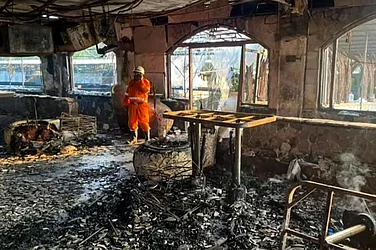India is all set to re-introduce cheetahs in the wild. The big cat had been declared extinct in India way back in 1952. This ambitious project is going to take off in the presence of PM Narendra Modi, who will welcome eight cheetahs on his birthday i.e. September 17, and will formally launch this project in Kuno National Park, Madhya Pradesh. As per reports, PM Modi will release cheetahs into quarantine enclosures at around 10.45 am.
The fourth big cat species will join the other three in India today, over half a century after it had gone extinct
Three Namibian male and five female adult cheetahs (between ages of two and five-and-a-half years) are making an 11-hour, transcontinental journey to reach Kuno National Park on September 17. Each cheetah is vaccinated and fitted with a satellite collar. The journey began on the afternoon of September 16, from the Hosea Kutako International Airport in Windhoek, capital city of Namibia. A private Boeing 747 jet loaded them for their journey to India.
Indian conservationists have been in discussion with the Cheetah Conservation Fund (CCF) since 2009. From then onwards, Laurie Marker, Bruce Brewer and Stephen J. O’Brien of CCF, at the invitation of the Indian government, have been visiting India to assess the site. On July 20, India signed a Memorandum of Understanding (MoU) with Republic of Namibia for latter's participation in India’s Project Cheetah that included the donation of the eight cheetahs for the launch of the project.
Bhupender Yadav, Union minister of environment, forest & climate change, believes this project will bring a lot of commercial opportunities for locals, and will also improve the local ecology. He said, “Project Cheetah will bring in resources to restore neglected habitats that in turn will conserve their biodiversity, harness their ecosystems, and their ability to sequester carbon to their maximum potential. The local communities also stand to gain enormously as ecotourism generated due to the curiosity and concern for the cheetah will give a boost to livelihood options for them and help improve living conditions”.
Kuno Palpur was also selected as a second home for lions in 2013. A Supreme Court bench of justices K.S. Radhakrishnan and C.K. Prasad found that Indian lions are under threat of extinction in Gir, and need a second home. Bench had given six months time to the wildlife authorities concerned for translocating the lions for this. But, due to strong objections by the Gujarat government, which claimed MP has a poor record of managing wildlife and lions are part of Gujarat’s unique heritage, the translocation of lions was stalled. Until now, the lion translocation has not become a reality.
Instead of bringing lions to Kuno, the Union government devised a plan to bring cheetahs from Africa. Interestingly, in 2012, the Supreme Court put a stay on the UPA government’s plan to bring cheetahs, saying the government needed to produce a detailed study before reintroduction of cheetahs. In 2020, while hearing an appeal by the National Tiger Conservation Authority, the SC allowed reintroduction of cheetahs on an “experimental basis", even though, a Supreme Court panel had advised against reintroduction of cheetahs earlier.
There has been a lot of discussion around cheetah reintroduction. Several critics of this project expressed apprehensions about it, saying the project is to “further stall lion translocation”, and it has “no scientific basis.” Supporters of “Project Cheetah”, though, compare it with the successful “Project Tiger”. They believe by bringing back a species that had gone extinct more than a half a century ago, India can become home to all four big cats – lion, leopard, tiger, cheetah. Moreover, the government has clarified that it has no intention to translocate lions at the moment.
Interestingly, southern african cheetahs were not India’s first choice. India first went to Iran to request for importing Asiatic cheetahs – the same species that went extinct here. But, Iran not only rejected the proposal, as Iran is itself struggling to conserve the limited population of this big cat. India then decided to import African cheetahs.
Meanwhile, descendents of the Palpur royal family have recently moved to court against the state government to get back their fortress located in the core area of the Kuno National Park. Palpur royals had to vacate it, and 260 bighas of land, when Kuno was selected for translocation of lions. Shreegopal Deo Singh, descendent of the royal family, which ruled Kuno-Palpur centuries ago, told media that “we gave it to lions, not cheetahs”, but lions are not coming.





















